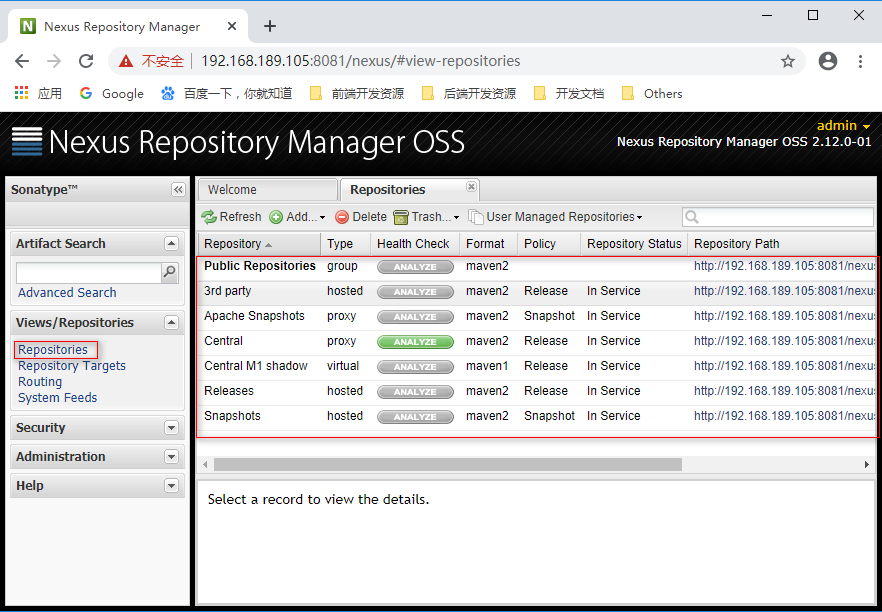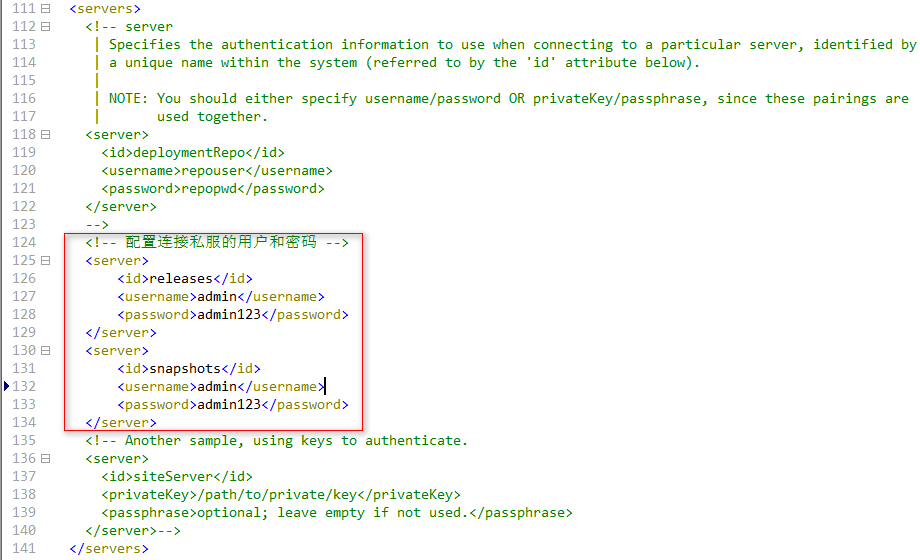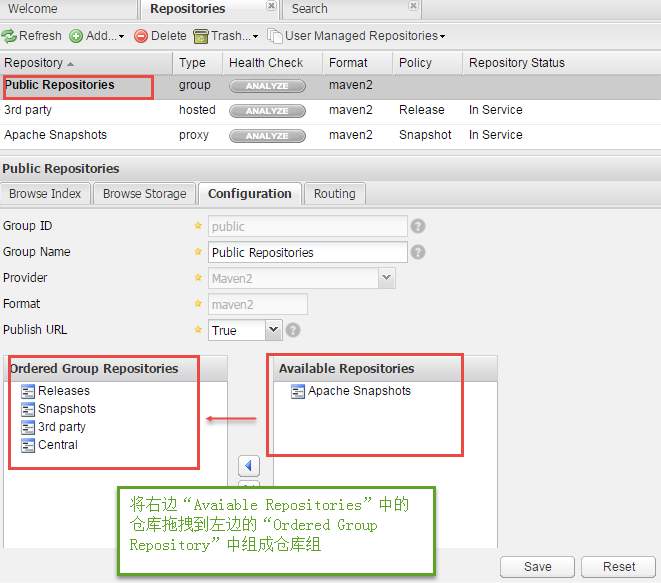概述
一、maven私服的结构
1、nexus仓库类型

1.1、hosted(宿主仓库)
部署自己的jar到这个类型的仓库,包括releases和snapshot两部分,Releases公司内部发布版本仓库、 Snapshots 公司内部测试版本仓库。
1.2、proxy(代理仓库)
用于代理远程的公共仓库,如maven中央仓库,用户连接私服,私服自动去中央仓库下载jar包或者插件。
1.3、group(仓库组)
用来合并多个hosted/proxy仓库,通常我们配置自己的maven连接仓库组。
1.4、virtual(虚拟)
兼容Maven1 版本的jar或者插件。
2、nexus仓库
- central:代理仓库,代理中央仓库
- pache-snapshots:代理仓库,存储snapshots构件,代理地址https://repository.apache.org/snapshots/
- central-m1:virtual类型仓库,兼容Maven1 版本的jar或者插件
- releases:本地仓库,存储releases构件。
- snapshots:本地仓库,存储snapshots构件。
- thirdparty:第三方仓库
- public:仓库组
二、maven私服的使用
1、将项目发布到私服
1.1、在maven的配置文件settings.xml配置连接私服的用户和密码

1.2、在项目的pom.xml文件中配置私服仓库的地址
<!--配置私服仓库的地址-->
<distributionManagement>
<repository>
<id>releases</id>
<url>http://localhost:8081/nexus/content/repositories/releases/</url>
</repository>
<snapshotRepository>
<id>snapshots</id>
<url>http://localhost:8081/nexus/content/repositories/snapshots/</url>
</snapshotRepository>
</distributionManagement>2、从私服下载jar包
2.1、打开nexus配置仓库组,设置如下:

2.2、在maven的配置文件settings.xml配置仓库
<profiles>
<!-- 下载jar包配置 -->
<profile>
<!--profile的id -->
<id>dev</id>
<repositories>
<repository> <!--仓库id,repositories可以配置多个仓库,保证id不重复 -->
<id>nexus</id> <!--仓库地址,即nexus仓库组的地址 -->
<url>http://localhost:8081/nexus/content/groups/public/</url> <!--是否下载releases构件 -->
<releases>
<enabled>true</enabled>
</releases> <!--是否下载snapshots构件 -->
<snapshots>
<enabled>true</enabled>
</snapshots>
</repository>
</repositories>
<pluginRepositories> <!-- 插件仓库,maven的运行依赖插件,也需要从私服下载插件 -->
<pluginRepository> <!-- 插件仓库的id不允许重复,如果重复后边配置会覆盖前边 -->
<id>public</id>
<name>Public Repositories</name>
<url>http://localhost:8081/nexus/content/groups/public/</url>
</pluginRepository>
</pluginRepositories>
</profile>
<profile>
<id>jdk-1.8</id>
<activation>
<activeByDefault>true</activeByDefault>
<jdk>1.8</jdk>
</activation>
<properties>
<maven.compiler.source>1.8</maven.compiler.source>
<maven.compiler.target>1.8</maven.compiler.target>
<maven.compiler.compilerVersion>1.8</maven.compiler.compilerVersion>
</properties>
</profile>
</profiles>2.3、激活使用profile定义的仓库,使之生效。
<!--激活使用profile定义的仓库-->
<activeProfiles>
<activeProfile>dev</activeProfile>
</activeProfiles>3、将第三方jar包放入私服
1、在maven的配置文件settings.xml中配置第三方仓库的server信息
<!--配置第三方仓库的server信息-->
<server>
<id>thirdparty</id>
<username>admin</username>
<password>admin123</password>
</server>2、执行安装第三方jar包到私服的命令
mvn deploy:deploy-file -DgroupId=项目的名称 -DartifactId=jar包名称 -Dversion=jar包版本 -Dpackaging=jar -Dfile=jar包所在目录及jar包文件名 -Durl=私服下载地址 -DrepositoryId=thirdparty
如:
mvn deploy:deploy-file -DgroupId=com.alibaba -DartifactId=fastjson -Dversion=1.1.37 -Dpackaging=jar -Dfile=H:TechnologyJavarepositoryfastjson-1.1.37.jar -Durl=http://localhost:8081/nexus/content/repositories/thirdparty/ -DrepositoryId=thirdparty
最后
以上就是谦让薯片为你收集整理的Maven学习(七):maven私服的使用的全部内容,希望文章能够帮你解决Maven学习(七):maven私服的使用所遇到的程序开发问题。
如果觉得靠谱客网站的内容还不错,欢迎将靠谱客网站推荐给程序员好友。
本图文内容来源于网友提供,作为学习参考使用,或来自网络收集整理,版权属于原作者所有。








发表评论 取消回复